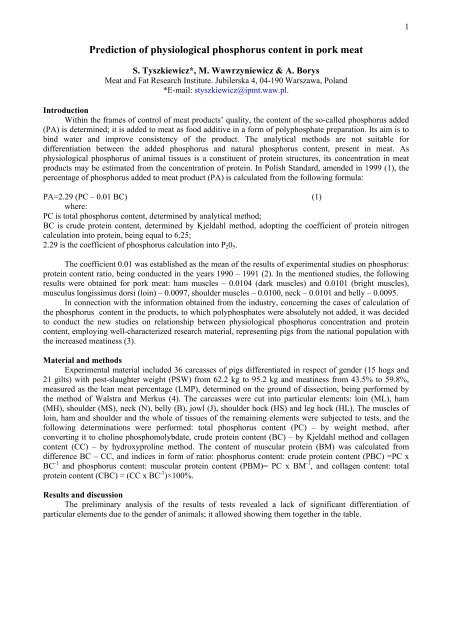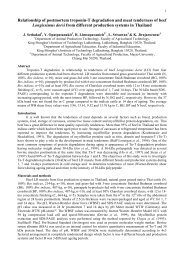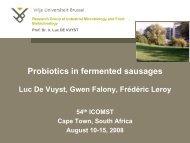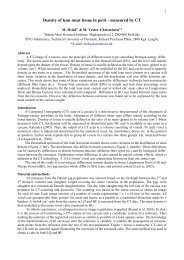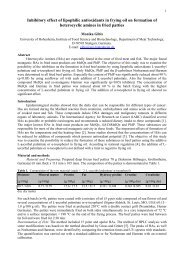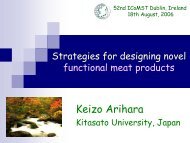Prediction of physiological phosphorus content in pork meat
Prediction of physiological phosphorus content in pork meat
Prediction of physiological phosphorus content in pork meat
Create successful ePaper yourself
Turn your PDF publications into a flip-book with our unique Google optimized e-Paper software.
1<br />
<strong>Prediction</strong> <strong>of</strong> <strong>physiological</strong> <strong>phosphorus</strong> <strong>content</strong> <strong>in</strong> <strong>pork</strong> <strong>meat</strong><br />
S. Tyszkiewicz*, M. Wawrzyniewicz & A. Borys<br />
Meat and Fat Research Institute. Jubilerska 4, 04-190 Warszawa, Poland<br />
*E-mail: styszkiewicz@ipmt.waw.pl.<br />
Introduction<br />
With<strong>in</strong> the frames <strong>of</strong> control <strong>of</strong> <strong>meat</strong> products’ quality, the <strong>content</strong> <strong>of</strong> the so-called <strong>phosphorus</strong> added<br />
(PA) is determ<strong>in</strong>ed; it is added to <strong>meat</strong> as food additive <strong>in</strong> a form <strong>of</strong> polyphosphate preparation. Its aim is to<br />
b<strong>in</strong>d water and improve consistency <strong>of</strong> the product. The analytical methods are not suitable for<br />
differentiation between the added <strong>phosphorus</strong> and natural <strong>phosphorus</strong> <strong>content</strong>, present <strong>in</strong> <strong>meat</strong>. As<br />
<strong>physiological</strong> <strong>phosphorus</strong> <strong>of</strong> animal tissues is a constituent <strong>of</strong> prote<strong>in</strong> structures, its concentration <strong>in</strong> <strong>meat</strong><br />
products may be estimated from the concentration <strong>of</strong> prote<strong>in</strong>. In Polish Standard, amended <strong>in</strong> 1999 (1), the<br />
percentage <strong>of</strong> <strong>phosphorus</strong> added to <strong>meat</strong> product (PA) is calculated from the follow<strong>in</strong>g formula:<br />
PA=2.29 (PC – 0.01 BC) (1)<br />
where:<br />
PC is total <strong>phosphorus</strong> <strong>content</strong>, determ<strong>in</strong>ed by analytical method;<br />
BC is crude prote<strong>in</strong> <strong>content</strong>, determ<strong>in</strong>ed by Kjeldahl method, adopt<strong>in</strong>g the coefficient <strong>of</strong> prote<strong>in</strong> nitrogen<br />
calculation <strong>in</strong>to prote<strong>in</strong>, be<strong>in</strong>g equal to 6.25;<br />
2.29 is the coefficient <strong>of</strong> <strong>phosphorus</strong> calculation <strong>in</strong>to P 2 0 5 .<br />
The coefficient 0.01 was established as the mean <strong>of</strong> the results <strong>of</strong> experimental studies on <strong>phosphorus</strong>:<br />
prote<strong>in</strong> <strong>content</strong> ratio, be<strong>in</strong>g conducted <strong>in</strong> the years 1990 – 1991 (2). In the mentioned studies, the follow<strong>in</strong>g<br />
results were obta<strong>in</strong>ed for <strong>pork</strong> <strong>meat</strong>: ham muscles – 0.0104 (dark muscles) and 0.0101 (bright muscles),<br />
musculus longissimus dorsi (lo<strong>in</strong>) – 0.0097, shoulder muscles – 0.0100, neck – 0.0101 and belly – 0.0095.<br />
In connection with the <strong>in</strong>formation obta<strong>in</strong>ed from the <strong>in</strong>dustry, concern<strong>in</strong>g the cases <strong>of</strong> calculation <strong>of</strong><br />
the <strong>phosphorus</strong> <strong>content</strong> <strong>in</strong> the products, to which polyphosphates were absolutely not added, it was decided<br />
to conduct the new studies on relationship between <strong>physiological</strong> <strong>phosphorus</strong> concentration and prote<strong>in</strong><br />
<strong>content</strong>, employ<strong>in</strong>g well-characterized research material, represent<strong>in</strong>g pigs from the national population with<br />
the <strong>in</strong>creased <strong>meat</strong><strong>in</strong>ess (3).<br />
Material and methods<br />
Experimental material <strong>in</strong>cluded 36 carcasses <strong>of</strong> pigs differentiated <strong>in</strong> respect <strong>of</strong> gender (15 hogs and<br />
21 gilts) with post-slaughter weight (PSW) from 62.2 kg to 95.2 kg and <strong>meat</strong><strong>in</strong>ess from 43.5% to 59.8%,<br />
measured as the lean <strong>meat</strong> percentage (LMP), determ<strong>in</strong>ed on the ground <strong>of</strong> dissection, be<strong>in</strong>g performed by<br />
the method <strong>of</strong> Walstra and Merkus (4). The carcasses were cut <strong>in</strong>to particular elements: lo<strong>in</strong> (ML), ham<br />
(MH), shoulder (MS), neck (N), belly (B), jowl (J), shoulder hock (HS) and leg hock (HL). The muscles <strong>of</strong><br />
lo<strong>in</strong>, ham and shoulder and the whole <strong>of</strong> tissues <strong>of</strong> the rema<strong>in</strong><strong>in</strong>g elements were subjected to tests, and the<br />
follow<strong>in</strong>g determ<strong>in</strong>ations were performed: total <strong>phosphorus</strong> <strong>content</strong> (PC) – by weight method, after<br />
convert<strong>in</strong>g it to chol<strong>in</strong>e phosphomolybdate, crude prote<strong>in</strong> <strong>content</strong> (BC) – by Kjeldahl method and collagen<br />
<strong>content</strong> (CC) – by hydroxyprol<strong>in</strong>e method. The <strong>content</strong> <strong>of</strong> muscular prote<strong>in</strong> (BM) was calculated from<br />
difference BC – CC, and <strong>in</strong>dices <strong>in</strong> form <strong>of</strong> ratio: <strong>phosphorus</strong> <strong>content</strong>: crude prote<strong>in</strong> <strong>content</strong> (PBC) =PC x<br />
BC -1 and <strong>phosphorus</strong> <strong>content</strong>: muscular prote<strong>in</strong> <strong>content</strong> (PBM)= PC x BM -1 , and collagen <strong>content</strong>: total<br />
prote<strong>in</strong> <strong>content</strong> (CBC) = (CC x BC -1 )×100%.<br />
Results and discussion<br />
The prelim<strong>in</strong>ary analysis <strong>of</strong> the results <strong>of</strong> tests revealed a lack <strong>of</strong> significant differentiation <strong>of</strong><br />
particular elements due to the gender <strong>of</strong> animals; it allowed show<strong>in</strong>g them together <strong>in</strong> the table.
2<br />
Table. Results <strong>of</strong> studies<br />
Paramiters<br />
Phosphorus<br />
Content<br />
Crude<br />
Prote<strong>in</strong><br />
Content<br />
Collagen<br />
Content<br />
Relation<br />
(CC×BC -1 )<br />
× 100%<br />
CBC<br />
%<br />
Muscular<br />
Prote<strong>in</strong><br />
Content<br />
BM<br />
%<br />
Relation<br />
PC×BC -1<br />
Relation<br />
PC×BM -1<br />
PC BC CC<br />
PBC PBM<br />
Carcass Cuts<br />
% ×10 -1 % %<br />
[-] × 10 -2 [-] × 10 -2<br />
Lo<strong>in</strong><br />
2.03 21.4 0.9 4.2 20.5 0.95 1.00<br />
ML S 0.06 1.2 0.2 1.3 0.05 0.05<br />
Ham<br />
2.03 20.3 0.8 3.9 19.6 1.00 1.04<br />
MH<br />
S 0.09 1.2 0.1 1.2 0.06 0.06<br />
Shoulder 1.98 19.6 1.1 5.6 18.6 1.01 1.07<br />
MS<br />
S 0.07 1.0 0.2 1.2 0.05 0.06<br />
Neck<br />
1.64 17.0 1.3 7.6 15.7 0.97 1.05<br />
N<br />
S 0.10 1.1 0.2 1.1 0.06 0.06<br />
Belly<br />
1.14 14.8 3.1 20.9 11.7 0.76 0.98<br />
B<br />
S 0.12 1.5 0.5 1.5 0.09 0.08<br />
Jowl<br />
1.22 13.7 2.3 16.8 11.4 0.88 1.07<br />
J<br />
S 0.17 1.6 0.5 1.8 0.08 0.09<br />
Shoulder 1.27 19.3 6.1 31.6 13.2 0.65 1.05<br />
Hock HS<br />
S 0.06 0.7 0.9 0.9 0.05 0.05<br />
Leg Hock 1.33 17.6 4.2 23.9 13.4 0.75 1.00<br />
HL<br />
S 0.06 0.8 0.7 0.8 0.04 0.06<br />
It is easy to notice that together with the <strong>in</strong>crease <strong>of</strong> collagen <strong>content</strong> <strong>in</strong> <strong>meat</strong>, <strong>phosphorus</strong>: total prote<strong>in</strong><br />
<strong>content</strong> (PBC) ratio is decreas<strong>in</strong>g; it <strong>in</strong>dicates that prote<strong>in</strong>s <strong>of</strong> connective tissue do not br<strong>in</strong>g or br<strong>in</strong>g<br />
considerably less <strong>phosphorus</strong> to the system than muscular prote<strong>in</strong>s do. It also results that total prote<strong>in</strong> <strong>content</strong><br />
itself is not a parameter suitable for predict<strong>in</strong>g <strong>phosphorus</strong> <strong>content</strong> <strong>in</strong> <strong>meat</strong> products. Much smaller<br />
differentiation and lack <strong>of</strong> noticeable relationship <strong>of</strong> <strong>phosphorus</strong>: muscular prote<strong>in</strong> ratio and collagen level,<br />
allowed suppos<strong>in</strong>g it would be easier to predict <strong>phosphorus</strong> <strong>content</strong> <strong>in</strong> <strong>meat</strong>, based on the <strong>content</strong> <strong>of</strong><br />
muscular prote<strong>in</strong> (BM) <strong>in</strong> <strong>meat</strong>. This speculation was confirmed by correlation calculus, be<strong>in</strong>g performed on<br />
<strong>in</strong>dividual results <strong>of</strong> determ<strong>in</strong>ation <strong>of</strong> <strong>phosphorus</strong> <strong>content</strong> (PC), crude prote<strong>in</strong> <strong>content</strong> (BC) and muscular<br />
prote<strong>in</strong> <strong>content</strong> (BM) for all the exam<strong>in</strong>ed samples. The regression equations have a follow<strong>in</strong>g form:<br />
PC=0.0104 BC – 0.0274 (2)<br />
with coefficient <strong>of</strong> determ<strong>in</strong>ation R 2 =0.585 and standard error <strong>of</strong> estimation 0.0243 and<br />
PC=0.0100 BM + 0.0340 (3)<br />
with coefficient <strong>of</strong> determ<strong>in</strong>ation R 2 =0.907 and standard error <strong>of</strong> estimation 0.0115.<br />
Significantly higher coefficient <strong>of</strong> determ<strong>in</strong>ation R 2 =0.930 and lower error <strong>of</strong> estimation 0.0100 is<br />
obta<strong>in</strong>ed when consider<strong>in</strong>g, besides <strong>of</strong> muscular prote<strong>in</strong>, also collagen <strong>content</strong> <strong>in</strong> equation (3). Then, the<br />
equation has a follow<strong>in</strong>g form:<br />
PC=0.00880 BM – 0.003845 CC + 0.0311 (4)<br />
It should be, however, mentioned that the equation, although be<strong>in</strong>g correct from calculat<strong>in</strong>g viewpo<strong>in</strong>t,<br />
has a doubtful chemical sense as it is difficult to imag<strong>in</strong>e “negative <strong>phosphorus</strong>” and such <strong>phosphorus</strong> would<br />
accompany collagen, occurr<strong>in</strong>g <strong>in</strong> connective tissue <strong>of</strong> <strong>meat</strong>. It may be supposed that s<strong>in</strong>g “ – “ <strong>in</strong> the<br />
equation (4) results from natural highly significant negative correlation between muscular prote<strong>in</strong> (BM) and<br />
collagen (CC) <strong>in</strong> different tissues, constitut<strong>in</strong>g the composition <strong>of</strong> <strong>meat</strong>. It may be also supposed that the<br />
prote<strong>in</strong>s <strong>of</strong> smooth muscles which accompany collagen <strong>in</strong> connective and fat tissue are also accompanied by<br />
other quantities <strong>of</strong> <strong>phosphorus</strong> than <strong>in</strong> case <strong>of</strong> prote<strong>in</strong>s <strong>of</strong> striated skeletal muscles.
Statistically significant effect <strong>of</strong> <strong>meat</strong><strong>in</strong>ess and LMR post-slaughter weight <strong>of</strong> carcass PSW on total<br />
<strong>phosphorus</strong> <strong>content</strong> PC and PBM <strong>in</strong>dex was found.<br />
The universal equation for predict<strong>in</strong>g <strong>of</strong> <strong>physiological</strong> <strong>content</strong> <strong>in</strong> <strong>pork</strong> <strong>meat</strong>, be<strong>in</strong>g the detailed equation (4)<br />
has a follow<strong>in</strong>g form:<br />
PC=0.00895 BM – 0.00366 CC – 0.000257 LMP – 0.000178 PSW + 0.0578 (5)<br />
It expla<strong>in</strong>s 93.3% variability with standard error <strong>of</strong> estimation equal to 0.00985. Alternative equation,<br />
describ<strong>in</strong>g the same percent <strong>of</strong> variability with the same error has a follow<strong>in</strong>g form:<br />
PC=0.00895 BC – 0.01260 CC – 0.000296 LMP – 0.000178 PSW + 0.0570 (6)<br />
Conclusions<br />
1. Any effect <strong>of</strong> pig gender on <strong>phosphorus</strong> <strong>content</strong> <strong>in</strong> <strong>meat</strong> was not found.<br />
2. Variability <strong>of</strong> <strong>phosphorus</strong> <strong>content</strong> <strong>in</strong> <strong>meat</strong> <strong>of</strong> particular elements <strong>of</strong> carcass, mak<strong>in</strong>g the univocal<br />
estimation <strong>of</strong> <strong>phosphorus</strong> <strong>content</strong> on the ground <strong>of</strong> prote<strong>in</strong> analysis, was found.<br />
3. It was found that determ<strong>in</strong>ation <strong>of</strong> crude prote<strong>in</strong> alone was not sufficient for predict<strong>in</strong>g <strong>of</strong><br />
<strong>physiological</strong> <strong>phosphorus</strong> <strong>content</strong> <strong>in</strong> <strong>pork</strong> <strong>meat</strong> and its products.<br />
4. Satisfactory estimation <strong>of</strong> <strong>physiological</strong> <strong>phosphorus</strong> <strong>content</strong> <strong>in</strong> <strong>pork</strong> <strong>meat</strong> based on total prote<strong>in</strong> and<br />
collagen <strong>content</strong> was obta<strong>in</strong>ed.<br />
5. Influence <strong>of</strong> carcass <strong>meat</strong><strong>in</strong>ess and post-slaughter weight <strong>of</strong> pigs on relative and absolute <strong>phosphorus</strong><br />
<strong>content</strong> <strong>in</strong> <strong>meat</strong> was demonstrated and considered <strong>in</strong> the universal equation <strong>of</strong> pigs on relative and<br />
absolute <strong>phosphorus</strong> <strong>content</strong> <strong>in</strong> <strong>meat</strong> was demonstrated and considered <strong>in</strong> the universal equation <strong>of</strong><br />
estimat<strong>in</strong>g <strong>physiological</strong> <strong>phosphorus</strong> <strong>content</strong> <strong>in</strong> <strong>meat</strong>.<br />
References<br />
1. Meat and <strong>meat</strong> products. Determ<strong>in</strong>ation <strong>of</strong> the <strong>phosphorus</strong> <strong>content</strong>. Polish Standard PN-A-82060.<br />
January 1999 (<strong>in</strong> Polish)<br />
2. Kłossowska B.M., Tyszkiewicz St. 1992. Content <strong>of</strong> natural <strong>phosphorus</strong> <strong>in</strong> <strong>meat</strong> ( <strong>in</strong> French). Buil.<br />
Liason CTSCCV, Paris, 6, 16 – 18<br />
3. Tyszkiewicz S. et al. 2005 Effect <strong>of</strong> carcass leanness <strong>in</strong> pig on prote<strong>in</strong> <strong>content</strong> and chemical<br />
composition <strong>of</strong> prime cuts. 51 ICoMST Baltimore, USA<br />
4. Walstra P., Merkus G.S.M. 1996. Procedure for assessment <strong>of</strong> the lean <strong>meat</strong> percentage as a<br />
consequence <strong>of</strong> the new EU reference dissection method <strong>in</strong> pig carcass classification. Report ID-DLO<br />
96.014, 1-22 Inst. for Animal Sci. and Health, Lelystand, Holland<br />
3


